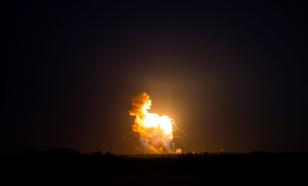Nuclear Submarines Project Launched in USSR 50 Years Ago
The competition between the USA and the USSR was immense

One may argue about the date of 50 years. At the end of 1952, Stalin signed a governmental decree about the start of the nuclear submarines project. In the summer of 1953, a group of nuclear scientists started working at the secret enterprise (currently called Sevmash Enterprise) in the northern city of Severodvinsk, the Arkhangelsk region. Probably, the project was launched because of the information obtained with the help of secret agents. Soviet intelligence managed to determine at the the time that the Americans were testing a nuclear engine, completing the construction of the first nuclear submarine.
In the summer of 1953, a group of nuclear scientists started working at the secret enterprise (currently called Sevmash Enterprise) in the northern city of Severodvinsk, the Arkhangelsk region. Probably, the project was launched because of the information obtained with the help of secret agents. Soviet intelligence managed to determine at the the time that the Americans were testing a nuclear engine, completing the construction of the first nuclear submarine.
The Soviets always tried to surpass the Americans. Why did Stalin decide to build nuclear submarines? It deems that it is impossible to find an answer to this question nowadays. Stalin's post-war program for the development of the Soviet Navy was in full swing at the end of 1952. A competent "primary source" called "Dead Water" published the following information: "The first post-war program stipulated the construction of nine 75,000 tonnage battleships, 15 aircraft carriers, 12 heavy cruisers, 60 light cruisers, and more than 500 submarines." Russia did not have its aircraft carriers, but Russian submarines are known worldwide. Those battleships were cut into metal scrap right in the building berths. Below is an excerpt from another "primary source," an American one. After the USSR's victory in WWII, Directive 20/1 of the US National Security Council ran (dated 08.18.1948): "To secure the nation by means of making the USSR leadership build expensive, but useless arms in peaceful times. Any hotspot will not be perspective after powerful nuclear weapons appear. It is not our business to think of internal consequences that might occur as a result of such a concept in another country. In addition to it, we are not supposed to think that we are responsible for these events. If Soviet leaders decide that the growing significance of more educated international relations concepts is incompatible with their power in Russia, it is their business, but not ours. Our business is to work and make internal events happen there."
"Mediators" around Soviet and Russian leaders have always been interested in ruining the country with useless arms. Probably, that was the reason why they destroyed heavy cruisers that would have been capable of neutralizing the threat of American aircraft carriers at any period - peaceful or not.
The Krasnaya Zvezda (Red Star) newspaper published the following information: "Unlike in the USA, the initiative was set forth by academicians, not military men - scientists I. Kurchatov, A. Alexandrov, A. Leipunsky. Academician Alexandrov, who subsequently become the President of the USSR Academy of Sciences, was the organizer and the scientific administrator in the field for 40 years, until he died. The construction of the first Soviet submarine was conducted at enterprise N402 - currently Sevmash Enterprise in Severodvinsk. The competition between the two superpowers was immense. There were several directions in the struggle: the number of nuclear cruisers in the navy, the nuclear capacity, their target and range precision, as well as the quality of nuclear energy installations - the capacity, weight, size, reliability, resource, noise and vibrating characteristics and so on and so forth. One shall acknowledge, the USA was ahead of the Soviet Navy for long from the point of view of nuclear submarines' number and their level of technology. Soviet subs were not as good as American ones from the point of view of noise and vibration peculiarities. On the other hand, Soviet submarines were superior in their available power, depth of submergence, they had better speed and larger reserve buoyancy. Russian submarines still hold the speed and submergence record – 1.000 meters and over 40 knots."
I had a chance to talk to several Soviet and Russian scientists, who had projected nuclear submarines, particularly at the famous company Rubin. No one of them could answer my question about the reason why so many various nuclear submarine projects were developed in the USSR. Americans had only a few projects that they modernize from time to time, adding new equipment and arms to them. What was the reason for the USSR to invent the fastest submarine (Plavnik, Komsomolets) or the largest submarine (Tayfun), if the most important operating characteristics of a sub is secrecy and low noise level.
Owing to the USSR's disadvantage in submarines' secrecy, nuclear cruisers were developed in the Soviet Union without any obstacles during the latest 50 years. One shall assume that they wanted to exhaust the national economy building the arms that were good for parades, albeit they were also dangerous for crewmembers. By the beginning of the 1990s, it became known that the nuclear submarines race of the two countries was extremely burdensome and hopeless.
However, the scale and the intensity of the competition between the navies of the two superpowers in the world's oceans became absolutely different at the end of the 20th century. About a 100 American and 200 Russian nuclear submarines have been removed from the naval arsenal. Both the USA and Russia are currently building just a few submarines.
It goes without saying that these polemic notes do not mean that nuclear submarines are not important when it comes to a national security. It is neither a hypothesis, nor even a version. It is just a question of a specialist.
On the photo: nuclear submarine equipped with ballistic missiles, project 667BDRM.
Subscribe to Pravda.Ru Telegram channel, Facebook, RSS!


